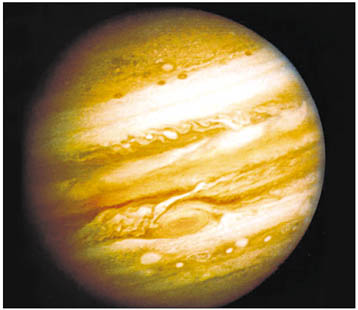
Latest Space Discoveries
, Pls keep adding
| Dimple |
 Aug 8 2007, 01:43 PM Aug 8 2007, 01:43 PM
Post
#1
|
|
Regular Member  Group: Members Posts: 585 Joined: 7-June 07 From: Bombay Member No.: 16381 |
Largest known planet discovered
-------------------------------------------------------------------------------- gas giant: The new planet — TrES-4 — is 70 per cent larger than Jupiter (left) Cape Canaveral (Florida): An international team of astronomers has discovered the largest known planet orbiting another star. The "transiting" planet — meaning one that passes in front of its parent star as seen from Earth — is about 70 per cent larger than Jupiter. But the presumed "gas giant" has a much lower mass than Jupiter — the biggest planet in our Solar System — making it of extremely low density. The new exoplanet, called TrES-4, is located in the constellation of Hercules and was discovered by a team working on the Transatlantic Exoplanet Survey (TrES). TrES-4 circles the star GSC02620-00648, which lies about 1,435 light-years away from Earth. Being only about 7 million km from its parent star, the planet is also very hot, about 1,327°C. Because of the relatively weak pull exerted by TrES-4 on its upper atmosphere, some of the atmosphere probably escapes in a curved comet-like tail. "TrES-4 is the largest known exoplanet," said lead author Georgi Mandushev, from the Lowell Observatory in Flagstaff, US. Surprising size It is so big, in fact, that its size is difficult to explain using current theories about superheated giant planets. "We continue to be surprised by how relatively large these giant planets can be," says Francis O'Donovan, a graduate student in astronomy at the California Institute of Technology which operates one of the TrES telescopes. — Agencies Attached image(s) 
"Shikwa nahin kisise, kisise gila nahin,
Naseeb mein nahin tha jo - humko mila nahin.."  |
  |
Replies
| Dimple |
 Oct 8 2007, 12:33 PM Oct 8 2007, 12:33 PM
Post
#2
|
|
Regular Member  Group: Members Posts: 585 Joined: 7-June 07 From: Bombay Member No.: 16381 |
Earth-like planet forming far away
AFP Thursday, October 04, 2007 21:07 IST It will take another one billion years for life to appear on this planet, which is 424 light years away Snuggled into a huge belt of warm dust, an Earth-like planet appears to be forming some 424 light years away, scientists said on Wednesday. At somewhere between 10 and 16 million years old, the planet’s solar system is still in its “very young adolescence,” but is at the perfect age for forming Earth-like planets, said lead researcher Carey Lisse of Johns Hopkins University’s Applied Physics Laboratory. The massive dust ring surrounding one of the system’s two stars is smack in the middle of the system’s “habitable zone” where water could one day exist on a rocky planet. These types of dust belts rarely form around sun-like stars and the presence of an outer ice belt makes it all the more likely that water, and subsequently life, could one day reach the planet’s surface. And this belt is made up of rocky compounds similar to those which form our Earth’s crust and metal sulfides similar to the material found in the Earth’s core. “It’s just the right stuff to be making an Earth,” Lisse said in a telephone interview. “It’s exciting to think that this is happening.” Not that Lisse will be around to see much of it. The images captured by NASA’s Spitzer Space Telescope are about 424 years old, but that’s barely a blink in the eye of the young planet. It will likely be about 100 million years before the planet is fully formed and — if our planet is anything to go by — about a billion years before the first signs of life such as algae appear, Lisse said. "Shikwa nahin kisise, kisise gila nahin,
Naseeb mein nahin tha jo - humko mila nahin.."  |
Posts in this topic
 Dimple Latest Space Discoveries Aug 8 2007, 01:43 PM
Dimple Latest Space Discoveries Aug 8 2007, 01:43 PM
 Dimple Distant space collision meant doom for dinosaurs
... Sep 6 2007, 04:12 PM
Dimple Distant space collision meant doom for dinosaurs
... Sep 6 2007, 04:12 PM
 Dimple NASA aims to put man on Mars by 2037
------------... Sep 25 2007, 01:31 PM
Dimple NASA aims to put man on Mars by 2037
------------... Sep 25 2007, 01:31 PM
 Mandrake Dimple, your PM facility doesn't work, so I co... Sep 25 2007, 06:40 PM
Mandrake Dimple, your PM facility doesn't work, so I co... Sep 25 2007, 06:40 PM
 Dimple Thank YOU Mandrake :) You are one of the few who h... Sep 26 2007, 10:11 AM
Dimple Thank YOU Mandrake :) You are one of the few who h... Sep 26 2007, 10:11 AM
 Dimple Mandrake :) It is very good to read appreciation l... Sep 26 2007, 11:15 AM
Dimple Mandrake :) It is very good to read appreciation l... Sep 26 2007, 11:15 AM
 Mandrake The PM facility has been withdrawn for all the mem... Sep 30 2007, 08:26 PM
Mandrake The PM facility has been withdrawn for all the mem... Sep 30 2007, 08:26 PM  |
1 User(s) are reading this topic (1 Guests and 0 Anonymous Users)
0 Members:

|
Lo-Fi Version | Disclaimer | HF Guidelines |  |
Time is now: 20th June 2025 - 12:29 PM |
Invision Power Board
v2.1.7 © 2025 IPS, Inc.
Licensed to: Hamaraforums.com









